In an increasingly urban, screen-saturated world, we’re more plugged in than ever—but often, more disconnected from ourselves. As stress, anxiety, and burnout continue to rise, people are seeking natural ways to feel better. One quiet, powerful remedy is gaining traction across the globe: forest bathing. Known in Japan as Shinrin-yoku, forest bathing is the simple yet profound act of immersing yourself in nature—not for exercise, but for healing and presence.
What Is Forest Bathing?
Forest bathing began in Japan in the 1980s as a response to the country’s tech-driven burnout culture. Scientists and doctors began studying the effects of spending time in wooded areas, and what they discovered was remarkable.
Forest bathing doesn’t involve actual water. The “bathing” refers to basking in the forest atmosphere—breathing in the fresh air, taking in the sights and sounds of trees, and moving slowly, intentionally, through natural surroundings. Think of it as mindful walking in nature, with a therapeutic twist.
The Science-Backed Benefits
What makes forest bathing more than just a walk in the woods is its proven impact on health and wellness. A growing body of research shows that regular exposure to natural environments—particularly forests—can:
- Reduce cortisol levels (the stress hormone)
- Lower blood pressure and heart rate
- Enhance immune function
- Boost mood and reduce anxiety
- Improve focus, creativity, and mental clarity
One key component is the inhalation of phytoncides—natural compounds released by trees and plants. These have been shown to boost natural killer (NK) cell activity, which helps the immune system fight disease and inflammation.
Why Forest Bathing Feels So Good
Beyond the physical benefits, forest bathing taps into something deeper. Nature has a unique ability to regulate the nervous system, moving us from the fight-or-flight mode into a state of rest and repair. The sounds of birdsong, rustling leaves, and flowing water calm the mind, while natural light helps regulate circadian rhythms and sleep patterns.
It’s also a chance to disconnect from technology, which studies have shown can improve mood, increase attention span, and foster deeper social connections when done regularly.
How to Try Forest Bathing for Yourself
You don’t need to live near a dense forest to reap the benefits of forest bathing. You simply need a patch of green space and an open mindset. Here’s how to get started:
- Find a quiet natural area—this could be a park, garden, or trail.
- Leave your phone behind, or put it on airplane mode.
- Walk slowly and silently, paying attention to your breath and senses.
- Use all five senses: notice the textures of bark, the scent of pine, the light filtering through leaves.
- Stay present. If your mind wanders, gently bring your focus back to your surroundings.
- Spend at least 20–30 minutes to start. Even short sessions can have measurable benefits.
You can also join guided forest therapy sessions led by certified practitioners, which are becoming more common in urban and rural areas alike.
Nature Is a Prescription Worth Filling
In a culture that often values productivity over presence, forest bathing offers a chance to simply be—without needing to achieve or accomplish anything. It’s about reconnecting with the natural world and, in doing so, reconnecting with yourself.
As we navigate modern life’s demands, forest bathing is more than a trend—it’s a powerful, proven tool for well-being. It reminds us that healing doesn’t always come in a bottle or a screen. Sometimes, it’s as close as the nearest tree-lined path.

